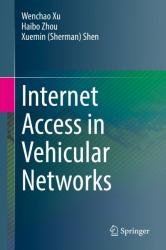 Название: Internet Access in Vehicular Networks
Название: Internet Access in Vehicular NetworksАвтор: Wenchao Xu, Haibo Zhou
Издательство: Springer
Год: 2021
Страниц: 176
Язык: английский
Формат: pdf (true), epub
Размер: 26.4 MB
This book introduces the Internet access for vehicles as well as novel communication and computing paradigms based on the Internet of vehicles.
To enable efficient and reliable Internet connection for mobile vehicle users, this book first introduces analytical modelling methods for the practical vehicle-to-roadside (V2R) Internet access procedure, and employ the interworking of V2R and vehicle-to-vehicle (V2V) to improve the network performance for a variety of automotive applications.
In addition, the wireless link performance between a vehicle and an Internet access station is investigated, and a machine learning based algorithm is proposed to improve the link throughout by selecting an efficient modulation and coding scheme.
This book also investigates the distributed Machine Learning algorithms over the Internet access of vehicles. A novel broadcasting scheme is designed to intelligently adjust the training users that are involved in the iteration rounds for an asynchronous federated learning scheme, which is shown to greatly improve the training efficiency. This book conducts the fully asynchronous machine learning evaluations among vehicle users that can utilize the opportunistic V2R communication to train Machine Learning models.
Modern vehicles generate a large amount of data for many emerging automotive applications, such as road safety, traffic management, autonomous driving, and intelligent transportation system. The Internet of vehicles are expected to enable effective acquiring, storage, transmission, and computing for such Big Data among vehicle users and thus can facilitate better perception of both internal and external vehicular environments as well as the status of drivers, passengers, and pedestrians. To efficiently connect mobile vehicles to the Internet and conduct massive information exchange among vehicle users and the transportation system, it is essential to evaluate the Internet access performance via both the vehicle-to-roadside (V2R) and vehicle-to-vehicle (V2V) paradigms. Besides, in order to support reliable and efficient Internet access for mobile vehicle users, it is very important to explore various spectrum resources rather than solely relying on cellular networks, such as unlicensed WiFi band, TV White Space, opportunistic V2V data path. To set up effective Internet connection, a practical signaling process between a roadside access station and vehicle users is necessary, e.g., various management frames need to be transferred to set up effective Internet connections. As vehicles move around, it is possible for them to set up opportunistic connections to share the data contents, bandwidth, and computing capacities, which can enable a variety of novel computing and communication paradigms that are beneficial to future automotive applications.
In this monograph, we investigate the Internet access procedure and the corresponding analytical evaluation methods, as well as novel machine learning paradigms for reliable and robust Internet connectivity on the road. We first introduce the Internet access of vehicles and propose an analytical framework for modeling of Internet access performance via the roadside hotspots, considering the necessary Internet access procedure that comprised of association, authentication, and network configuration steps, where the access delay and throughput capacity are evaluated in drive-thru Internet scenario. We then explore the interworking of different V2X communication paradigms and study the opportunistic assistance from neighboring vehicles, which apply the V2V communication to conduct Internet data offloading upon the interworking of V2V and V2R communication, where the trade-off between the delay and throughput of the V2V assistance is analyzed. In addition, we take a close look at the wireless link management between the vehicle and Internet access stations. We investigate the V2X channel that is highly varying and thus difficult to accommodate proper modulation and coding scheme to satisfy various user quality-of-service (QoS). To deal with such issue, we apply Big Data analytics and show that the proposed data-driven and learning-based methods can greatly reduce the packet drop rate and thus improve the Internet access performance in terms of both access delay and transmission throughput.
Researchers and advanced-level students who focus on vehicular networks, industrial entities for internet of vehicles providers, government agencies target on transportation system and road management will find this book useful as reference. Network device manufacturers and network operators will also want to purchase this book.
Скачать Internet Access in Vehicular Networks